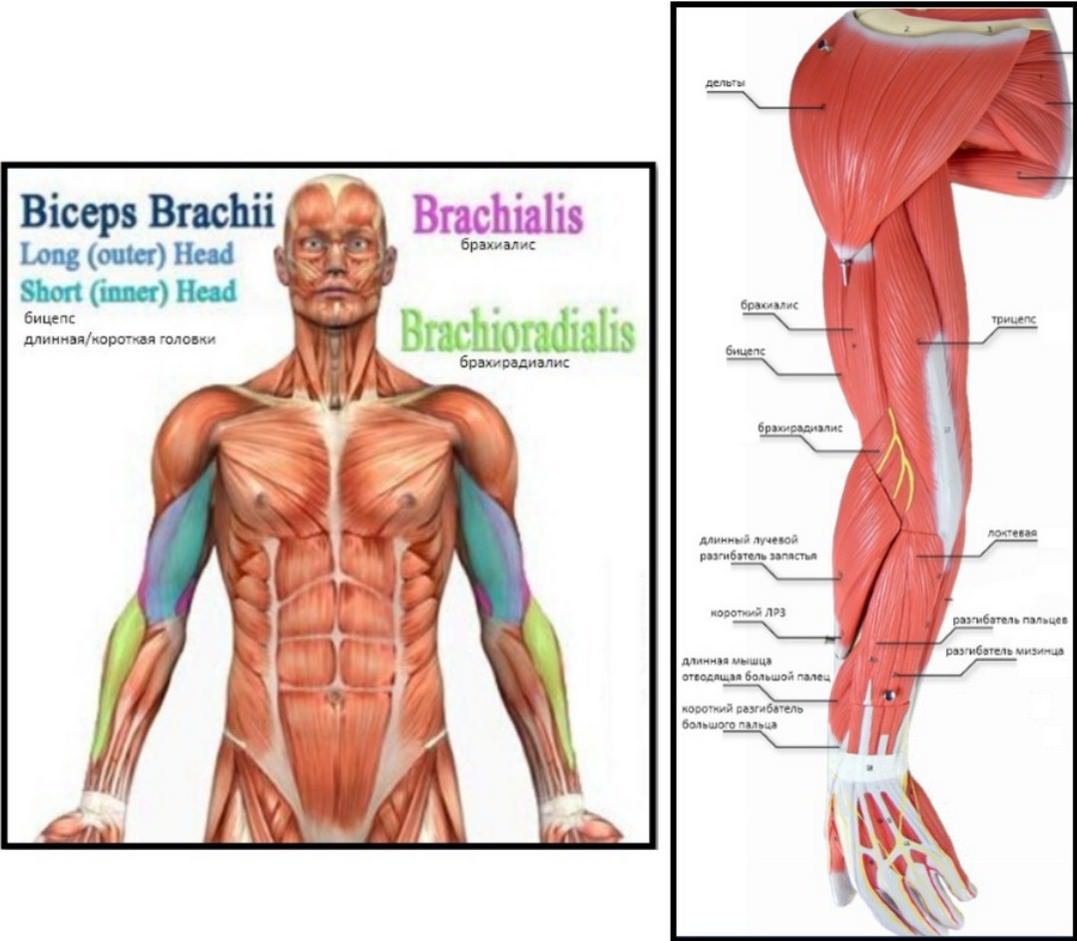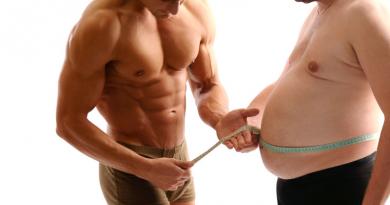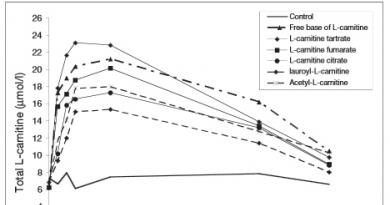My respect, my dear girls and fitness girls! Sunday is a tedious day on the project, and all because we are considering theoretical issues, today, for example, it will be the anatomy of the arm muscles. After reading, everyone will have an idea of the structure of this muscle group, its functions, and will become more intelligent in choosing pumping exercises.
So, sit down, good gentlemen, let's go.
Anatomy of the arm muscles: what, why and why?
Who loves theoretical articles, raise your hand...forest of hands. Usually there are very few such people, to be honest, I also feel sleepy from reading a sheet of thuja with a bunch of symbols, and even of an anatomical nature. Therefore, I try in every possible way to avoid unnecessary theory, but not at the expense of the quality of the note. On the other hand, many of you understand that you cannot go far without a foundation, and such notes are extremely important and necessary. So today we will continue the glorious tradition of forcing and consider the question “Anatomy of the arm muscles.” Whether you fall asleep or not, we will find out about this at the very end of the article, so let’s start moving towards it.
Note:
For better assimilation of the material, all further narration will be divided into subchapters.
Why you need to pump your arms
Yes, actually, it’s not necessary to download them and it’s not really necessary :), because they make up 5-7% of all muscular volumes of the body, therefore they cannot theoretically give any significant increase in mass. Often, many training programs, for example, for ectomorphs, completely exclude this muscle group or devote the least time to it. Of course, the hands are involved in almost all movements and receive their load indirectly, but still it cannot be compared with targeted and highly specialized work. Therefore, you need to shake your hands, at least for this reason:
- as various surveys show (including posting notes), Ladies pay significant attention to their hands. In muscular arms they feel the strength and ability to protect and not allow them to be offended;
- pumped up arms look good in summer in various sleeveless T-shirts - this is a sign of good physical shape of their owner;
- when you are asked to show your pumped up muscles, you always show your biceps;
- in the men's world, volume matters, so if you have weak hands, then the attitude towards you is appropriate;
- strong hands are the ability to resist holds/choke and deliver a crushing blow to an opponent;
- for women, toned arms and strong forearms/hands are a plus in everyday life, such as carrying bags or carrying a child;
- for women - this is the absence of jelly and various sagging under the arms;
- If you have muscle-toned arms, you can afford sleeveless and open-shoulder dresses.
In my opinion, an impressive list for learning a little more about the anatomy of the arm muscles and working on your playful little hands.
Anatomy of arm muscles: atlas
The arm muscles have many large, externally visible muscles that help us in everyday activities, such as changing clothes or using a PC.
The muscles of the upper limbs are divided into:
- shoulder muscles, which in turn are divided into the anterior group (flexors) - brachialis, coracobrachialis, biceps and posterior (extensors) - ulna, triceps;
- The muscles of the forearm are the largest, these are the brachialis (brachialis) and the brachioradialis (brachyradialis).
From the point of view of occurrence, it is customary to distinguish:
- superficial (clearly visible on the surface)– biceps, triceps, brachyradialis, long extensor carpi radialis, deltas;
- deep muscles - lie deep on the surface.

The muscles of the upper arm are responsible for flexion/extension of the forearm at the elbow joint. Flexion of the forearm is achieved by a group of three muscles - the brachialis, biceps and brachyradialis. In general, in the literature on anatomy it is not customary to translate the names of muscle groups, i.e. there, for the preservation of the original Latin names, for example, brachialis will be musculus brachialis. In this regard, a more correct “Latin anatomical picture” of the arm muscles will look like this.

Let's look at the major large muscle units individually.
No. 1. Biceps
The large, thick fusiform brachii muscle, located on the top of the humerus, consists of 2 -x heads – long and short. Both originate in the shoulder area, attach below to the round eminence of the forearm bone, and unite in the middle of the shoulder.

The biceps performs the following functions:
- works as a forearm supinator by turning and moving the palm up;
- flexes forearm/shoulder;
- flexes the upper arm (raise your arm forward and up).
No. 2. Triceps
The triceps fusiform muscle lies on the back of the shoulder. It has three heads - lateral (lateral), medial (medial) and long (long), which merge on the olecranon process of the ulna. The lateral and medial heads of the triceps originate on the humerus, the long one begins on the scapula.

The triceps performs the following functions:
- extends the elbow joint/helps straighten the arm - acts as an extensor of the forearm at the elbow joint and humerus at the shoulder;
- The long head also assists the latissimus dorsi during the bench pullover exercise, bringing the arm down toward the body.
Summarizing the “head” muscles, the combined anatomical picture of biceps + triceps looks like this.

No. 3. Forearm muscles
The most famous and largest muscles of the wrist are: brachialis, brachyradialis, flexor carpi radialis longus and coracoid muscles. Let's look at them in more detail.
3.1. Brachialis
Most of the muscles that move the wrist, arm and fingers are found in the forearm - they are thin, like a strap. The brachialis is a flat, fusiform muscle that lies under the biceps on the lower anterior surface of the shoulder. The beginning is attached to the bottom of the humerus, and the “end” is attached to the bony eminence of the forearm.
Brachialis performs the following functions:
- the main and strongest elbow flexor - responsible for bending the elbow in any position of the hand (supination, pronation, neutral).
3.2. Brachyradialis
This is a fusiform muscle located on the front surface of the forearm. Originates at the lower outer shoulder, crosses the elbow and extends to the radius (outer bottom). To see the muscle, tense your forearm and move your thumb to the side; the brachiralis will “appear” near the elbow, closer to the biceps tendon.
The brachioradialis muscle performs the following functions:
- bends the elbow;
- plays an active role in the up/down rotation of the forearm.
3.3. Extensor carpi radialis longus
On the back of the arm are extensor muscles such as extensor carpi ulnaris and extensor digitorum longus, which act as antagonistic flexors. The extensors are somewhat weaker than the flexors. The extensor carpi radialis longus is located next to the brachyradialis and is one of the 5 core muscles that help move the wrist. When a person clenches a fist, this muscle is actively involved and protrudes from the skin.
Note:
The muscles on the front of the forearm, such as the flexor carpi radialis and flexor digitorum superficialis, form the flexor group that flexes the hand at the wrist and each of the phalanges. Inflammation of this area can lead to pain and numbness known as carpal tunnel syndrome.
3.4. Coracobrachialis muscle
A long, narrow, beak-shaped muscle located on the inner surface of the shoulder. At the top it is attached near the coracoid process of the scapula, and at the bottom - to the front inner part of the arm. This muscle is not an elbow flexor
The coracobrachialis muscle performs the following functions:
- bringing the arm toward the body with the elbow bent.
A composite atlas of all the muscles of the forearms looks like this.

Actually, we're done with anatomy. Friends, are you still here...or am I just shaking the air? :). Let's go further and now talk about practical training aspects.
Supination and pronation - what is it?
These are two special movements produced by the muscles of the forearms - supination (outward rotation) and pronation (turn inward). Supination is produced by the biceps and the muscles of the round supinator of the forearms, pronation - by the muscles of the pronator teres of the forearms.
It turns out that the different grip of the projectile (for example dumbbells) provides different types of work for the arms and different degrees of participation of the biceps/triceps and forearms muscles.

Let's move on to the practical part of the note.
Anatomy of arm muscles: how to train correctly
Let's go over the anatomical features of the arm muscles and, as a result, derive some rules for their effective training. And we'll start with...
No. 1. Biceps
The biceps is a superficial muscle, so the indicative appearance of your hand muscles will depend on its quality development. The main movements in which he participates are lifting the projectile from bottom to top, i.e. bringing it to the chest. To create the peak of the biceps, it is necessary to use lifts with supination during the exercise - turning the hand upward when the palm faces the ceiling and the little finger is located above the thumb, or lifts with an already supinated hand.
The best exercises for biceps:
- standing barbell/dumbbell lifts (straight/EZ bar);
- reverse grip pull-ups;
- dumbbell lifts while sitting at an upward angle from an extended position;

It is worth understanding that the shape of the biceps is laid in you by Mother Nature; it can be long with short ligaments or short with long ends of the ligaments (like Schwarzenegger).
No. 2. Triceps
Triceps makes up 2/3 part of the volume of the arms, therefore, if the arms do not have enough volume, then it is necessary first of all to “hammer” the triceps and only then the biceps. The main “profession” of all three triceps heads is extension of the arm at the elbow joint, while the medial one is the most active of all heads. Triceps antagonists (biceps, brachialis) are physiologically more powerful than the triceps muscle, which is manifested in a slight bend of the arms at the elbow when they hang freely during rest.
For the qualitative development of the triceps brachii muscle, it is necessary to use flexion/extension exercises with free weight. Quality means an increase in the volume-strength characteristics of a given muscle group. Don't spend time on isolated exercise machines (guys, leave them to the girls) it is better to use multi-joint exercises in which everything is immediately “captured” into work 3 triceps heads.
The best triceps exercises:
- reverse push-ups from a bench;
- dips;
- close grip bench press.

No. 3. Forearm muscles
High-quality anatomy of the arm muscles requires good development of this muscle group. The brachialis muscle creates a supporting platform for the biceps, as if pushing it to the “surface”. The brachialis is activated by static elbow flexion and works in all biceps exercises, but it is best engaged during reverse-grip biceps curls.
The brachioradialis (brachyradialis) muscle is actively involved in the work when lifting dumbbells with a hammer grip, i.e. when the thumb points up. The coracoid muscle plays an important role in the development of hand muscles and is clearly visible in the double biceps pose in front. The best way to hit the coracoid muscle is to do dumbbell lifts in front of you, dumbbell flyes while lying on a bench.
The best exercises for the forearms:
- spider curls (barbell lifts with reverse grip);
- hummer lifts (lifting dumbbells with a hammer grip);
- wrist straight/reverse lifts of the barbell from a bench while kneeling.

Uff-f, well, that’s all, actually, now let’s sum it up and say goodbye.
Afterword
The anatomy of the arm muscles is the question we studied today. Now you know what and how the stump works :) and how to swing it correctly. There is very little left to put the theory into practice, so let’s blow into the hall and swing.
That's all, I was glad to write for you, see you again!
PS. Dear, what exercises do you use to train your arms?
P.P.S. Did the project help? Then leave a link to it in your social network status - plus 100 points towards karma, guaranteed.
With respect and gratitude, Dmitry Protasov.



